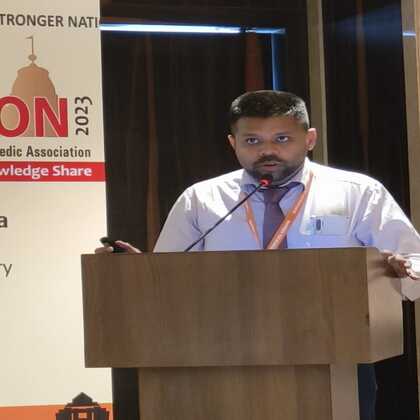Understanding Cervical Spondylitis: Symptoms, Management and Prevention
Learn more about cervical spondylitis, its causes and symptoms, treatment options and prevention strategies to manage and protect your spine health effectively.

Written by
Last updated on 3rd Jul, 2025
Introduction
Cervical spondylitis occurs when the neck’s cartilage, bones, and ligaments start to wear and tear with or without age. In the past, healthcare professionals would associate cervical spondylitis and spondylosis primarily with ageing. However, today, with the present generation and their lifestyle, spondylitis, and spondylosis are not restricted to any specific age group. Cervical refers to seven stacked bones (vertebrae) in the neck, whereas spondylitis is a type of arthritis that causes inflammation in the spine. It can also affect the joints and ligaments of the spine and other joints in the body. Healthcare providers sometimes call it Spondyloarthritis (SpA). It is often caused by genetic factors such as ankylosing spondylitis (AS).
Cervical Spine Anatomy
The cervical spine consists of seven vertebrae (C1-C7) that form the bony structure of the neck. It supports the weight of the head, facilitates movement and houses the spinal cord. The discs between the vertebrae act as cushions, while facet joints help enable flexibility. These components work together to provide stability and mobility of the neck. However, with age and strain, these structures may undergo degenerative changes. The protective cartilage may wear down, and bone spurs may develop, which may contribute to stiffness and discomfort. Understanding the anatomy of the cervical spine helps in identifying the affected areas and planning treatment.
Prevalence of Cervical Spondylitis
Cervical spondylitis may predominantly affect people aged 40 and older, with its prevalence increasing significantly in those over 60. It may be more common in men than women, and may have a higher prevalence among people leading a sedentary lifestyle. Across the world, cervical spondylitis is considered one of the leading causes of neck pain. It highlights the importance of public awareness and early intervention to help reduce its impact.
Main Types of Spondylitis
Below-mentioned are a few main types of spondylitis:
Ankylosing Spondylitis (AS): It is a long-term inflammatory disease, affecting the spine and other joints. It can cause stiffness, pain, and, eventually, fusion of the vertebrae in the spine.
Psoriatic Arthritis (PsA): It is an inflammatory disease that affects the joints, ligaments, and tendons.
Reactive Arthritis: It happens after an infection occurs in another part of the body. It may cause inflammation in the eyes, joints and urinary tract.
Enteropathic Arthritis: It is specifically classified as a “spondyloarthropathy” because it is an inflammatory arthritis associated with inflammatory bowel disease (IBD). It may often involve inflammation in the spine.
Undifferentiated Spondylitis: More accurately called Undifferentiated Spondyloarthritis (USpA), it is a condition where a person has symptoms that suggest spondyloarthritis (SpA) but do not meet the diagnostic criteria for any specific type of SpA. It is also sometimes called Undifferentiated Spondyloarthropathy.
Juvenile Spondylitis (JSpA): It is a chronic disease that specifically refers to the condition when spondylitis (inflammation of the spine) occurs in children or young adults.
What are the Causes of Cervical Spondylitis?
Below are a few causes of cervical spondylitis:
Genetic Influence: The susceptibility to cervical spondylitis may increase with a family history of spinal disorders, which may suggest a genetic predisposition. Individuals with certain inherited traits, such as weak connective tissues, may make them more prone to early degenerative changes.
Degenerative Changes: Disc dehydration and shrinkage may be caused by natural ageing. This may lead to reduced flexibility and the formation of bone spurs (osteophytes). These degenerative changes are considered the primary cause of cervical spondylitis. With age, these changes may result in spinal canal narrowing (stenosis) or even compressed nerve roots.
Lifestyle Factors: Healthcare professionals believe that lack of exercise or physical activities, prolonged use of laptops, and poor posture contribute to excessive strain on the cervical spine. This may accelerate degenerative processes. For example, a phenomenon called the ‘tech neck’ may be caused by looking down at devices for longer periods of time, which has emerged as a significant contributor. Also, sedentary habits combined with inadequate ergonomics may further aggravate the condition. Addressing and managing these factors may help slow progression.
What are the Symptoms of Cervical Spondylitis?
A few symptoms of cervical spondylitis are mentioned below:
Neurological Symptoms: Nerves may compress in the cervical spine, leading to radiating pain, tingling, or weakness in the hands, arms, and shoulders, or numbness. Severe cases may even lead to issues with grip strength or coordination difficulties.
Stiffness or Neck Pain: Hallmark symptoms of cervical spondylitis may include persistent stiffness and pain in the neck, especially in the mornings or after prolonged periods of inactivity. These symptoms may even get worse with specific movements or physical exertion.
Associated Symptoms: Some associated symptoms often reported by people with cervical spondylitis include reduced range of motion in the neck, dizziness, and headaches. Due to nerve involvement, some may also experience visual disturbances or ringing in the ears.
Consult Top Orthopaedician
Risk Factors Associated with Cervical Spondylitis
Mentioned below are a few risk factors that could be associated with cervical spondylitis:
Injuries or Trauma: A person with a history of neck injuries or trauma can predispose them to early degenerative changes in the cervical spine. For example, whiplash injuries that may be sustained during a car accident may lead to chronic issues if not properly managed.
Occupational Risks: People with jobs that involve more neck movements, prolonged use of laptops and smartphones or heavy lifting may increase the risk of cervical spondylitis. Professions such as drivers, desk workers and assembly line workers may be more vulnerable.
Gender and Age: The risk of developing cervical spondylitis may increase with age, particularly after 40 years. Men may be slightly more prone to the condition than women due to differences in physical activity levels and occupational stressors.
What are the Potential Complications of Untreated Cervical Spondylitis?
There could be potential complications of cervical spondylitis if left untreated, such as:
Neurological Deficits: In severe cases, it may lead to permanent nerve damage, which may cause loss of sensation, weakness, or paralysis in affected areas. Hence, early intervention is crucial in preventing irreversible damage.
Chronic Pain: Persistency in neck pain can significantly impact day-to-day activities and overall well-being. Over time, this pain may lead to sleep disturbances and also mental challenges such as depression or anxiety.
Mobility Limitations: Untreated cervical spondylitis may limit mobility, hinder professional performance and even affect mental health. Due to physical limitations and chronic discomfort, patients may experience social isolation.
Treatment Options for Cervical Spondylitis
There are a few treatment options patients with cervical spondylitis can opt for:
Surgical Treatments: Surgery may be considered in cases where conservative treatments fail, and symptoms like spinal instability and nerve compression persist. Procedures include:
Spinal decompression.
Fusion surgery.
Advanced technique like minimally invasive surgery.
Non-Surgical Treatments: In cases that are not as severe, a few non-surgical treatments may be suggested by doctors, like:
Exercises for strengthening neck muscles and improving flexibility.
Ergonomic practises and avoiding strenuous activities.
Anti-inflammatory drugs, pain relievers and muscle relaxants.
Other modalities like chiropractic care, massage therapy, and acupuncture may also provide relief.
Emergency Therapies: Innovative treatments such as platelet-rich plasma (PRP) injections and stem cell therapy may help regenerate damaged tissues and relieve symptoms. While these therapies are still under research, they hold potential for future management.
Prevention Strategies for Treating Cervical Spondylitis
Patients with cervical spondylitis can opt for below-mentioned prevention strategies:
Preventing Injuries: To minimise the risk of injuries, patients must wear protective gear during sports and avoid sudden neck movements. Warm-ups before physical activity are also crucial.
Investing in Workplace Ergonomics: Investing in ergonomic furniture and taking regular breaks from screen work can help prevent unnecessary strain on the neck. For long-term spinal health, an optimal workstation setup is also essential.
Conclusion
Cervical spondylitis is a common yet manageable condition. Early diagnosis, appropriate treatments, and preventative measures can help improve outcomes significantly and enhance the quality of life.
Consult Top Orthopaedician
Consult Top Orthopaedician
Dr. Anil Sharma
Orthopaedician
42 Years • MBBS, MS Orthopedics
New Delhi
AAKASH MEDSQUARE, New Delhi

Dr. Anil Pradeep Jadhav
Orthopaedician
23 Years • MBBS MS (Ortho)
Nashik
Apollo Hospitals Nashik, Nashik
(25+ Patients)

Dr. Pradeep Lucas
Orthopaedician
7 Years • MBBS, Diploma in Orthopaedics, Fellowship in DFSI
Bengaluru
Revival Multispeciality Clinic, Bengaluru

Dr. Manoj Dinkar
Orthopaedician
15 Years • MBBS, Dip (Orthopaedics)
New Delhi
THE DOCTORS NESST, New Delhi

Dr. Mriganka Ghosh
Orthopaedician
11 Years • MD (Physician), DNB (Orthopaedics)
Howrah
Dr Mriganka Mouli Ghosh, Howrah
Consult Top Orthopaedician
Dr. Anil Sharma
Orthopaedician
42 Years • MBBS, MS Orthopedics
New Delhi
AAKASH MEDSQUARE, New Delhi

Dr. Anil Pradeep Jadhav
Orthopaedician
23 Years • MBBS MS (Ortho)
Nashik
Apollo Hospitals Nashik, Nashik
(25+ Patients)

Dr. Pradeep Lucas
Orthopaedician
7 Years • MBBS, Diploma in Orthopaedics, Fellowship in DFSI
Bengaluru
Revival Multispeciality Clinic, Bengaluru

Dr. Manoj Dinkar
Orthopaedician
15 Years • MBBS, Dip (Orthopaedics)
New Delhi
THE DOCTORS NESST, New Delhi

Dr. Mriganka Ghosh
Orthopaedician
11 Years • MD (Physician), DNB (Orthopaedics)
Howrah
Dr Mriganka Mouli Ghosh, Howrah

